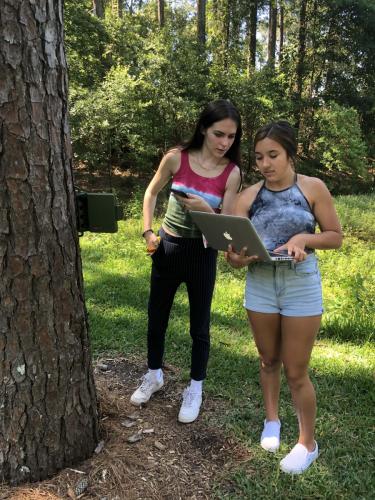NACOGDOCHES, Texas — Sounds of chirping frogs filled the air, but it wasn’t coming from the pond students in Stephen F. Austin State University’s STEM Academy sat near. Sarah Riley and Kennedy Tinajero listened intently on a laptop to breeding frog calls they recorded, counting the number of frogs and seeking to identify the different types of calls for a project examining the factors that influence frog behavior.
Entering their senior year at Lufkin High School, Tinajero and Riley have been a part of SFA’s STEM Academy since their freshman year, exploring science, technology, engineering and mathematics. While most of their learning has taken place in a classroom setting in the past, they now have the opportunity to conduct research in the field with the help of SFA faculty members.
“Every year we get to learn something new and discover what we’re most passionate about,” Riley said. “This year we got to go off on our own, do research, and meet with professors and learn what they do, so this has been a really special experience for us.”
Riley and Tinajero are using a Song Meter borrowed from the U.S. Department of Agriculture Forest Service Southern Research Station to collect data from a pond inside the Lufkin city limits, as well as utilizing data collected by the Forest Service from a pond in a local national forest. The Song Meter records sounds for a minute every hour from 9 p.m. to 2 a.m., giving the students six minutes of data per site to analyze.
“We’re trying to see what factors play into the calls, learn about the different types of calls and see how many frogs there are,” Tinajero said. “It’s really interesting, and I’m happy that we’re doing it.”
Because there is an increase in breeding frog call activity during the summer months, the students will be able to record several species of frogs to determine species richness, said Dr. Erin Childress, lecturer in SFA’s Department of Biology. Childress assisted the students with initially sorting through the data, pointing out the different frog calls.
“My vision as a mentor is for these students to think about the entire scope of a research project from beginning to end,” Childress said. “This includes thinking about broad questions they have about nature, narrowing down what specific questions they are curious about, and considering what methods are most appropriate for analyzing the data, what knowledge is gained from the results of the data, how this information adds to the broader scope of knowledge, and what limitations they faced in this study that could have influenced the conclusions they make.”
Students in SFA’s STEM Academy begin high school with a cohort of students and progress through elective courses with them. The students are encouraged and expected to enroll in dual credit and advanced mathematics and science courses, said Dr. Jana Redfield, assistant director of the STEM Research and Learning Center.
“The students in the cohort work in SFA laboratories on college-level experiments guided by university faculty members and lab assistants,” Redfield said. “They sharpen their cooperative learning skills during these laboratory sessions. They are also challenged to think and problem-solve and are given the opportunity to conduct independent research.”
To learn more about STEM Academy and the STEM Research and Learning Center, visit sfasu.edu/STEM.

 Axe ’Em, Jacks!
Axe ’Em, Jacks!
